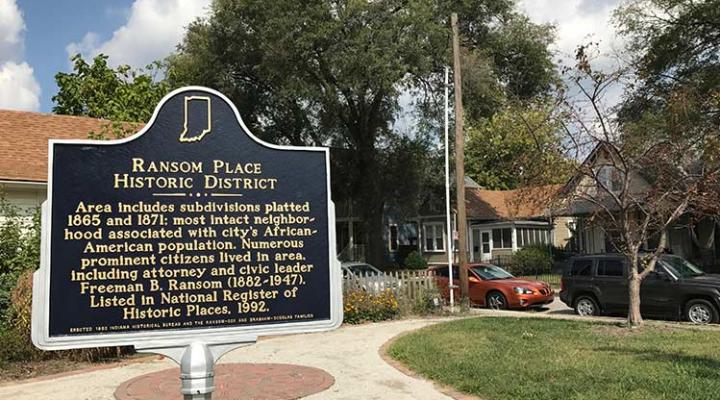Historical Significance
Development in the Late 19th Century
Ransom Place, established in the late 1800s, is recognized as Indianapolis’ first African American neighborhood. Located near downtown, it became a haven for Black families seeking opportunity and community during a time when segregation limited access to many parts of the city. The neighborhood’s development reflected the broader history of African American migration to urban centers during the post-Civil War period, as families sought economic stability and refuge from systemic racism in rural areas.
Reflecting Broader Black History
As one of the few neighborhoods where African Americans could own property and build businesses, Ransom Place embodied the resilience and ingenuity of Black communities across the nation. It stood as a testament to the determination to thrive in the face of adversity, offering a supportive environment where residents could succeed despite societal barriers.
A Thriving Neighborhood
By the early 20th century, Ransom Place was a bustling community with homes, schools, churches, and businesses that catered to its residents. It became a beacon of Black excellence in Indianapolis, fostering a sense of pride and belonging for generations of families.
Cultural Impact
The Legacy of Freeman Ransom
One of the neighborhood’s most prominent residents was Freeman Ransom, an attorney, business leader, and community advocate. As the legal counsel and general manager for Madam C.J. Walker, he helped grow her haircare empire and supported numerous initiatives to uplift the Black community. His work extended beyond business, as he championed education, civil rights, and economic empowerment for African Americans.
Fostering Black-Owned Businesses
Ransom Place became a hub for Black entrepreneurship, with many residents owning businesses that provided goods and services to the community. These businesses not only supported the local economy but also reinforced a sense of independence and self-sufficiency among residents.
Institutions of Empowerment
The neighborhood was home to several institutions that served as pillars of the community, including schools, churches, and social organizations. These institutions provided education, spiritual guidance, and resources that empowered residents to build a better future for themselves and their families.
Preservation Efforts
Challenges Amid Urban Development
Like many historic neighborhoods, Ransom Place faced significant challenges in the mid-20th century due to urban renewal projects and gentrification. The expansion of downtown Indianapolis and infrastructure projects displaced many families, leading to the loss of homes and businesses that were integral to the community’s identity.
Successes in Historical Preservation
In the 1990s, Ransom Place was designated as a historic district, ensuring the preservation of its unique architecture and cultural significance. This designation marked a turning point, protecting the neighborhood from further erosion and recognizing its importance in the city’s history.
Community Advocacy and Revitalization
The preservation of Ransom Place was driven by the passion and dedication of its residents and community advocates. Organizations like Indiana Landmarks and the Madam Walker Legacy Center played a crucial role in preserving its legacy. Today, their efforts serve as a reminder of the power of grassroots advocacy in maintaining cultural heritage.
Exploring Ransom Place Today
A Stroll Through History
Walking through Ransom Place offers a glimpse into the past, with beautifully preserved homes and historical markers that tell the stories of its residents. The cobblestone streets and charming architecture transport visitors back to a time when the neighborhood was a thriving center of African American life.
Educational Resources
Institutions like the Madam Walker Legacy Center and the Indiana Historical Society provide resources and exhibits that delve into the rich history of Ransom Place. These organizations ensure that the stories of its residents are preserved and shared with future generations.
A Living Legacy
Ransom Place remains a vibrant neighborhood that continues to inspire. Its history serves as a source of pride for Indianapolis, reminding residents of the strength and contributions of the city’s African American community.
How Lockstep Realty Supports Historic Communities
At Lockstep Realty, part of eXp Realty, we are committed to celebrating and preserving Indianapolis’ historic neighborhoods. Whether it’s connecting buyers with homes that reflect their values or supporting initiatives that honor local heritage, we’re passionate about fostering communities that cherish their past while looking toward the future. Ransom Place is a shining example of the resilience and achievements of Indianapolis’ African American history, and we’re proud to share its story.
Frequently Asked Questions (FAQs)
- What is the historical significance of Ransom Place?
Ransom Place is Indianapolis’ first African American neighborhood, established in the late 19th century as a thriving hub for Black families and businesses. - Who was Freeman Ransom, and why is he important?
Freeman Ransom was a prominent attorney and business leader who worked with Madam C.J. Walker and played a key role in empowering the community. - What preservation efforts have been made for Ransom Place?
The neighborhood was designated as a historic district in the 1990s, protecting its architecture and legacy from urban development pressures. - Are there educational resources about Ransom Place?
Yes, institutions like the Madam Walker Legacy Center and the Indiana Historical Society provide exhibits and programs highlighting its history. - How does Lockstep Realty support historic neighborhoods?
We connect buyers with homes in culturally significant areas, promote preservation efforts, and advocate for community engagement to keep neighborhoods thriving.



